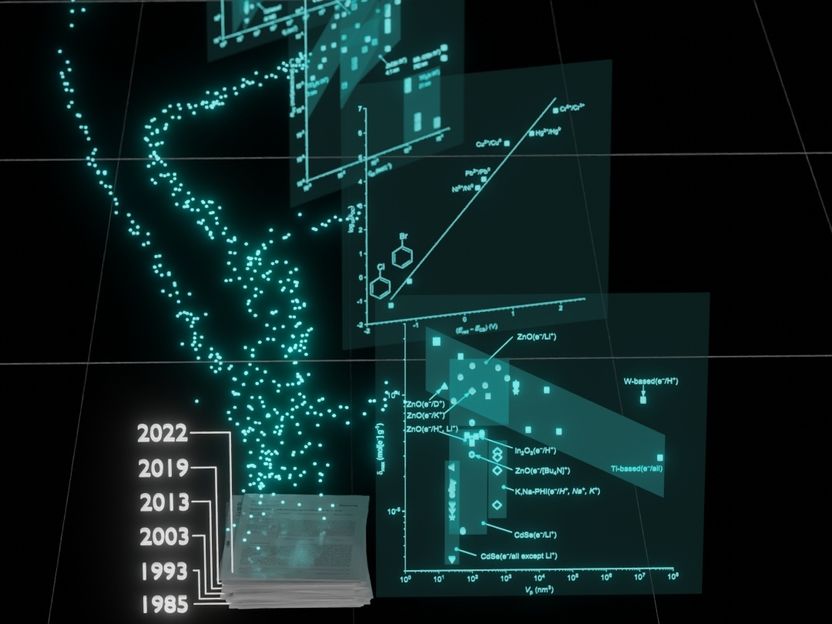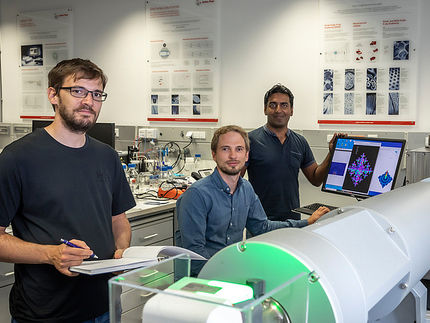Battery research - First online database on photocharged materials developed
Data was extracted from scientific articles published in the past 40 years and now is available in the form of interactive graphs online
Advertisement
Dr. Aleksandr Savateev, group leader at the Max Planck Institute of Colloids and Interfaces, has developed a unique online database. To do so, he has analyzed and standardized research data from 300 papers published over the past forty years in the field of photocharged semiconductors. The database could be used to find suitable photosemiconductors for designing new batteries, rechargeable batteries and supercapacitors more quickly and in a more targeted manner.

Data was extracted from scientific articles published in the past 40 years and now is available in the form of interactive graphs online.
© Dr. Aleksandr Savateev/Max Planck Institute of Colloids and Interfaces
Materials chemistry is a rapidly evolving area of research, with thousands of various semiconductors, and more materials being added all the time. What material among this variety would be the best for application in solar batteries, for example? How should such a material look like if it has not yet been synthesized? To this end, Dr. Aleksandr Savateev has analyzed research data dealing with the charging of materials by light and compiled their results: "Scientists generate enormous amount of data. Within a single research article, the data are analyzed, trends are derived and explained. However, comprehensive analysis of data spanning decades of research, even from one field, is very rare. The lack of such analysis ultimately delays the implementation of technological developments - and this is where the database comes in," explains Dr. Savateev. Forty years ago, a physical phenomenon was observed and studied that could make it possible to combine a light harvester and a battery in one device. Solar farms generate renewable electricity, but solar panels cannot store it yet. Various semiconductor materials, including those composed of abundant elements, such as carbon and nitrogen, are photocharged when irradiated with visible light. Similar to an electric battery, a semiconductor remains charged in the dark for hours and even days, and the energy stored in a photocharged semiconductor may be used on demand for various purposes: "The database could help find the right semiconductors much quicker," Savateev says.
Photo chargeable semiconductors may not only be used to convert solar light to charge smartphones, research laboratories around the world are using these materials instead of rare elements and expensive reagents to obtain value-added organic compounds. Organic chemists and materials scientists can use the online database on photocharged materials for their research to select the most suitable semiconductor material. Various filters can be applied to highlight the desired data points according to a specific criterion. Already, certain trends between the structure of semiconductor materials and their ability for photocharging may be derived from the properties compiled in the database. These dependencies are available in the open access article published in "Advanced Energy Materials".
About the database
This review summarizes and quantifies experimental data collected over 40 years of research. Maximum specific concentration of electrons stored in 1 g of a semiconductor, maximum average number of electrons stored per semiconductor particle, initial rate of photocharging, and the initial rate of discharging are calculated for six classes of semiconductor materials: Ti, Zn, Cd, In, W-based, and graphitic carbon nitrides. Dependence of these parameters on the specific surface area of the material, particle volume, and other properties is analyzed and trends are derived. A public database of photocharged materials has been created to facilitate design of high-performing materials with photocharging function, their application as rechargeable reductants in organic synthesis and the development of devices.
Original publication
Other news from the department science
Most read news
More news from our other portals
See the theme worlds for related content
Topic World Battery Technology
The topic world Battery Technology combines relevant knowledge in a unique way. Here you will find everything about suppliers and their products, webinars, white papers, catalogs and brochures.

Topic World Battery Technology
The topic world Battery Technology combines relevant knowledge in a unique way. Here you will find everything about suppliers and their products, webinars, white papers, catalogs and brochures.



























































